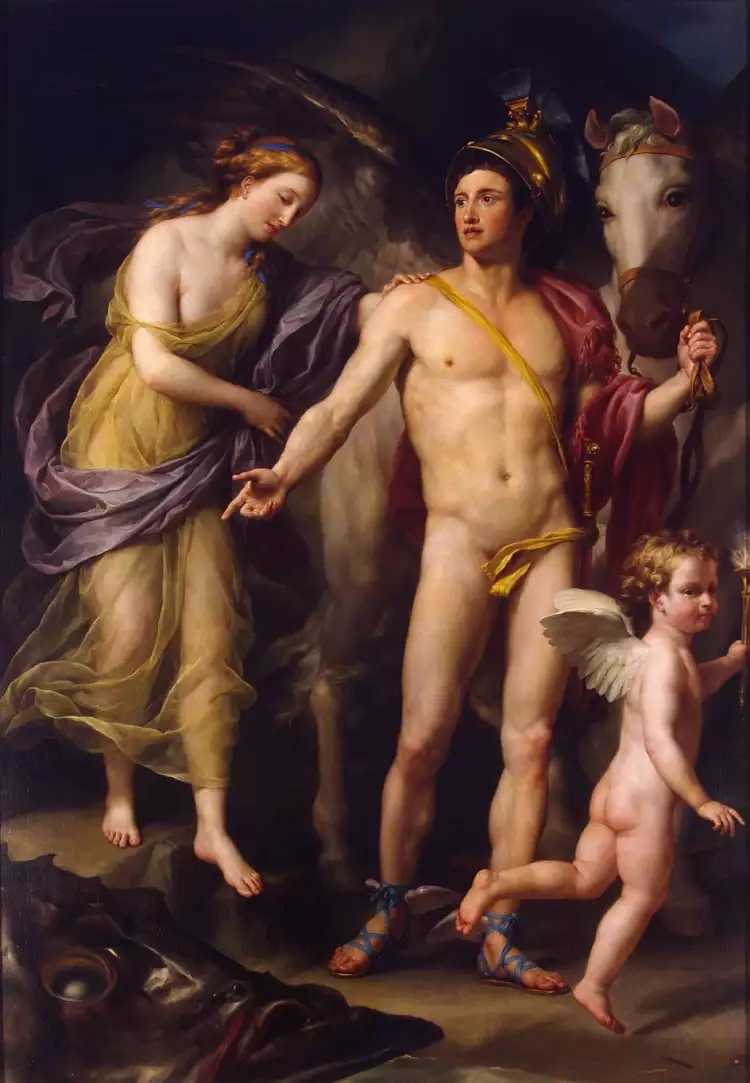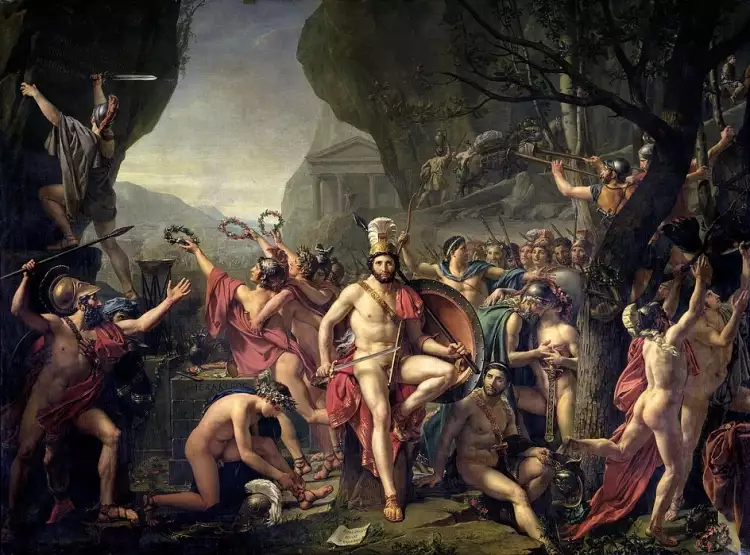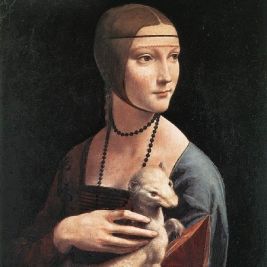
Neoclassicism: once again, an alignment with ancient ideals!
What is Neoclassicism? It's impossible to provide a definitive answer to this question. The challenge lies in the fact that there are two art historical approaches to defining the term Neoclassicism. In global art history, the term refers to a style that shaped aesthetic tastes in the late 18th to early 19th centuries, the era of Anton Raphael Mengs, Anselm von Feuerbach, and Jacques-Louis David. In Russian science, the term is applied to an artistic movement from the late 19th to early 20th century, and a wide range of painters, from followers of the Pre-Raphaelites to Petrov-Vodkin, are considered neoclassicists.
 Neoclassicism. Jacques-Louis David. Sappho and Phaon, 1809
Neoclassicism. Jacques-Louis David. Sappho and Phaon, 1809
Why did this happen to Neoclassicism? It might be connected to the late arrival of classical influences in Russia. Classicism began to develop in the Russian Empire in the second half of the 18th century, when France was already under the influence of refined Rococo, transitioning to the Neoclassical trend. As a result, the so-called Russian classicism corresponds in time to European Neoclassicism and, from the perspective of global art history, is a part of it. However, in Russia, the tradition was established to simply call this period classicism, which was partly transferred to European art as well.
 Neoclassicism. Jacques-Louis David. Oath of the Horatii, 1784
Neoclassicism. Jacques-Louis David. Oath of the Horatii, 1784
In Russia, neoclassicists came to be known as artists of the late 19th and early 20th centuries who worked based on ancient traditions, for example, neoidéalistes. A similar approach is observed in Germany, where national classicist painters also appeared relatively late.
This is how terminological confusion arose. Attempts to eliminate it have been made, but discrepancies persist. What to do? Perhaps, regarding the late 19th and 20th centuries, it's better to use another term—Neoclassicism. And simply acknowledge the coexistence of the two approaches, specifying exactly what is meant.
 Neoclassicism. Joseph-Marie Vien. Sweet Melancholy, 1756
Neoclassicism. Joseph-Marie Vien. Sweet Melancholy, 1756
The Second Wave of Classicism in Europe
So, let's turn to the so-called second wave of classical aesthetics that surged in Europe in the late 18th century. The first wave, by the mid-18th century, was replaced by Rococo painting—subtle, elegant, ornate, and lightweight. However, by the 1760s, criticism of Rococo began, signaling a return to the strictness of forms and the dramatic content.
 Neoclassicism. Anton Raphael Mengs. Flagelación de Cristo, 1769
Neoclassicism. Anton Raphael Mengs. Flagelación de Cristo, 1769
Simultaneously, thanks to excavations in Pompeii and Herculaneum, there was a vivid revival of interest in antiquity. Painters became acquainted with frescoes and other examples of ancient art.
 Neoclassicism. Joseph-Marie Vien. L’Athénienne vertueuse, 1762
Neoclassicism. Joseph-Marie Vien. L’Athénienne vertueuse, 1762
Johann Joachim Winckelmann, a German archaeologist, made a significant contribution to the development of the updated classical aesthetic with his multi-volume 'Antiquities of Herculaneum' and his work dedicated to ancient Roman art. It urged artists to emulate the ancients in the pursuit of high artistic ideals.
 Neoclassicism. Jacques-Louis David. The Death of Socrates, 1787
Neoclassicism. Jacques-Louis David. The Death of Socrates, 1787
This is perhaps the main distinction of neoclassicists from their predecessors. While classical artists drew on the legacy of the Renaissance, painters of the second wave sought inspiration, like Renaissance masters, from the primary source.
 Neoclassicism. Angelika Kauffmann. Venus Induces Helen to Fall in Love with Paris, 1790
Neoclassicism. Angelika Kauffmann. Venus Induces Helen to Fall in Love with Paris, 1790
The influence of the Enlightenment should also be noted: philosophers preached rationalism, advocated for reliance on reason, and aimed for an understanding of the world and the study of natural laws. This philosophical platform became the basis for neoclassicists.
 Neoclassicism. Angelika Kauffmann. Poetry embraces Painting, 1782
Neoclassicism. Angelika Kauffmann. Poetry embraces Painting, 1782
Thus, a new aesthetic direction is born, within which several sub-styles emerged. For example, the Louis XVI style stands out, with some transitional and eclectic features: a peculiar Rococo classicism.
 Neoclassicism. Anton Raphael Mengs. Perseus and Andromeda, 1776
Neoclassicism. Anton Raphael Mengs. Perseus and Andromeda, 1776
Many researchers classify the pompous Empire style as one of these sub-styles. Additionally, neoclassical painters strongly expressed national characteristics, giving their works a distinctive flavor.
 Neoclassicism. Anne-Louis Girodet de Roucy-Trioson. Portrait of Hortense de Beauharnais, 1809
Neoclassicism. Anne-Louis Girodet de Roucy-Trioson. Portrait of Hortense de Beauharnais, 1809
Characteristics of neoclassicism in painting:
- A tendency towards strictness and restraint.
- Rejection of baroque and Rococo extravagance.
- Clarity of lines, sculptural forms on canvases.
- Demand for smooth technique: the viewer should not see brushstrokes.
- Celebration of eternal values, self-sacrifice, heroism.
- Grandeur and aristocracy (patricianism) of images.
- Dramatic and epic nature of subjects.
- A significant interest in history.
 Neoclassicism. Jacques-Louis David. Leonidas at Thermopylae, 1814
Neoclassicism. Jacques-Louis David. Leonidas at Thermopylae, 1814
Neoclassicism gives a powerful impetus to the development of historical and portrait genres. Neoclassical masters, like their predecessors, often turned to stories from ancient history and mythology. But something innovative emerged: an interest in national legends and epics. Portraits acquired strict grandeur: artists sought to depict the inner strength of individuals.
 Neoclassicism. Jacques-Louis David. Napoleon Crossing the Alps, 1801
Neoclassicism. Jacques-Louis David. Napoleon Crossing the Alps, 1801
It should be noted that despite the similarity of principles between the two waves, they are not identical. Neoclassicism is more realistic, sometimes sharper and more severe. Even with all the antagonism of the directions, there was some influence of the Baroque. This influence manifested in the dramatization of painting, introducing powerful Baroque dynamics, which was absent in the calm paintings of the first wave classical masters.
 Neoclassicism. Anne-Louis Girodet de Roucy-Trioson. Malvina dying in Fingal's arms
Neoclassicism. Anne-Louis Girodet de Roucy-Trioson. Malvina dying in Fingal's arms
The dramatic effect in many neoclassical works is achieved through the use of light and shadow contrasts, similar to the Caravaggists. For example, Jacques-Louis David admired Caravaggio's work, and this influence was reflected in the formation of the painter's individual style.
 Neoclassicism. Jacques-Louis David. The Death of Marat, 1793
Neoclassicism. Jacques-Louis David. The Death of Marat, 1793
Famous Masters of Neoclassicism
At the origins of the second wave stood Anton Raphael Mengs, who called for a rejection of Rococo aesthetics and a return to strict ideals. Interestingly, his work shows the influence of the Baroque in the presentation of light and shadow contrasts and the grandiosity of portraits.
 Neoclassicism. Anton Raphael Mengs. Noli Me Tangere, 1763
Neoclassicism. Anton Raphael Mengs. Noli Me Tangere, 1763
On the other hand, for Mengs, the precise depiction of an individual's personality and realism were characteristic.
 Neoclassicism. Anton Raphael Mengs. Sybil, 1761
Neoclassicism. Anton Raphael Mengs. Sybil, 1761
The paintings of Joseph-Marie Vien, a transition from Rococo to Neoclassical aesthetics, demonstrate the shift. Vien was the teacher of Jacques-Louis David.
 Neoclassicism. Joseph-Marie Vien. Callisto, nymphe de Diane sortant du bain, 1763
Neoclassicism. Joseph-Marie Vien. Callisto, nymphe de Diane sortant du bain, 1763
Paintings by Joseph-Marie Vien, a teacher of Jacques-Louis David, demonstrate the transition from Rococo to Neoclassical aesthetics. In the work of his student, the new style reached its crescendo. Remarkably, David's creativity was not homogeneous, combining Baroque, classical, and romantic features in a surprising way.
 Neoclassicism. Jacques-Louis David. Portrait of Madame Récamier, 1800
Neoclassicism. Jacques-Louis David. Portrait of Madame Récamier, 1800
The works of David from 1780-1800 are the most classically restrained yet theatrically expressive.
 Neoclassicism. Jacques-Louis David. Belisarius Begging for Alms, 1781
Neoclassicism. Jacques-Louis David. Belisarius Begging for Alms, 1781
Other artists working in this style include:
- Anne-Louis Girodet de Roucy-Trioson, who hinted at a transition to Romanticism.
- Jean Auguste Dominique Ingres, who, however, is more appropriately classified as an academic painter.
- Angelica Kauffman, an Austrian artist and a co-founder of the Royal Academy of Arts in London.
- John Vanderlyn, who brought new tendencies from Paris to America.
 Neoclassicism. John Vanderlyn. Landing of Columbus, 1847
Neoclassicism. John Vanderlyn. Landing of Columbus, 1847
Gradually, the audience grew weary of the somewhat rigid Neoclassical art, and the era of Romanticism emerged. New tendencies manifested in the paintings of well-known figures of the time, such as Jacques-Louis David. Nevertheless, Greco-Roman ideals were destined to return to canvases, albeit on a smaller scale.
 Neoclassicism. Joseph-Marie Vien. La Marchande à la toilette, 1763
Neoclassicism. Joseph-Marie Vien. La Marchande à la toilette, 1763
Neoclassicism
As mentioned earlier, in the late 19th and early 20th centuries, a number of painters once again turned to ancient heritage.
 Neoclassicism. Anselm Feuerbach. Iphigenia, 1862
Neoclassicism. Anselm Feuerbach. Iphigenia, 1862
Whether to call these trends Neoclassicism or Neoclassical is a question of terminology and, perhaps, secondary. What is more important is the understanding of where these flashes of interest in ancient traditions on the threshold of modern art originated.
 Neoclassicism. Anselm Feuerbach. Ruhende Nymphe, 1870
Neoclassicism. Anselm Feuerbach. Ruhende Nymphe, 1870
Masters who turned to the examples of Renaissance, Greek, and Roman art during this time did so as part of an artistic protest (in contrast to academic and salon art, which formally used classicist canons). Advocates of Neoclassicism, unlike academicians, sought true inspiration in antiquity, a way to overcome the "chaos of reality" or any new trends that seemed unaesthetic and destructive (such as engaging in polemics with the avant-garde).
 Neoclassicism. Zinaida Serebriakova. Self-Portrait as Pierrot, 1911
Neoclassicism. Zinaida Serebriakova. Self-Portrait as Pierrot, 1911
Who can be considered late-period Neoclassicists:
- Partly the refined Pre-Raphaelites, who oriented themselves towards Renaissance masterpieces rooted in antiquity.
- Neo-idealists, a movement that formed in the 1870s in Germany, with a notable representative being Anselm von Feuerbach and his romantically-classicist approach.
- Several representatives of the modern culture, including Ferdinand Hodler, Maurice Denis, Pierre Puvis de Chavannes, Alexandre Jacovleff (Russian: Александр Евгеньевич Яковлев), Zinaida Serebriakova (Russian: Зинаида Евгеньевна Серебрякова), who creatively combined modernist and classicist stylistics.
- The "New Society of Artists," formed in 1904 (including Alexander Gustav Hausch, Boris Kustodiev (Russian: Борис Михайлович Кустодиев)).
- Some masters who turned to the aesthetic canons of classicism, even if not always evident – for example, the strict plasticity of Kuzma Petrov-Vodkin (Russian: Кузьма Сергеевич Петров-Водкин) has its roots here.
Neoclassicism. Anselm Feuerbach. Portrait of Anna Risi, 1861
Are such works popular at contemporary auctions? Certainly, and for two reasons. Firstly, paintings from the 18th to 19th centuries have high investment value, even if they belong to second or third-tier artists (bids on the VeryImportantLot website start from a few thousand euros). Well-known canvases are valued in the millions. Secondly, these works attract aesthetes with magnificent technique, precision of forms and lines, the grandeur of themes, and the beauty of images. Such a painting is desired for purchase at an auction for a personal collection and to adorn a classical interior.
 Photography is an art accessible to everyone
Photography is an art accessible to everyone  Jewelry craftsmanship - an ancient art of creating unique masterpieces from precious materials
Jewelry craftsmanship - an ancient art of creating unique masterpieces from precious materials  The painting "The Clothed Maja" by Francisco Goya is a delightful Spanish commoner in a provocative attire
The painting "The Clothed Maja" by Francisco Goya is a delightful Spanish commoner in a provocative attire  The painting "The Wanderer" by Vasily Grigorievich Perov portrays the image of noble poverty and human dignity
The painting "The Wanderer" by Vasily Grigorievich Perov portrays the image of noble poverty and human dignity  The painting "Stepan Razin" by Vasily Surikov is a tragic truth that triumphs over the epic image
The painting "Stepan Razin" by Vasily Surikov is a tragic truth that triumphs over the epic image  The top 10 most famous Italian artists - the greatest masters of painting in Italy of all time
The top 10 most famous Italian artists - the greatest masters of painting in Italy of all time  Expressionism - a shocking emotional movement in 20th-century art
Expressionism - a shocking emotional movement in 20th-century art  The most famous expressionist artists
The most famous expressionist artists  The Resurgence of Vintage Kitchen and Barware: A Collector’s Delight
The Resurgence of Vintage Kitchen and Barware: A Collector’s Delight  Hermann Historica Auction: Kunst, Antiquitäten & Antiken
Hermann Historica Auction: Kunst, Antiquitäten & Antiken